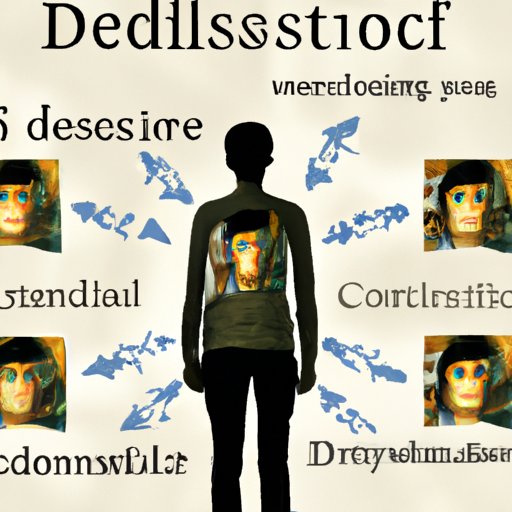Introduction
Dissociative identity disorder (DID), formerly known as multiple personality disorder, is a complex and rare mental health condition in which a person has two or more distinct identities or personalities. It is believed to be caused by a combination of factors, including genetics, trauma, abuse, early childhood experiences, psychobiology, and family systems. This article will explore the various causes of DID and discuss potential treatments.

Examining the Genetic Predisposition of DID
Recent research suggests that there may be a genetic component to DID. Studies have shown that people with a family history of dissociative disorders, such as DID, are more likely to develop the condition themselves. Other risk factors include a history of mental illness and trauma in the family.
Genetics play an important role in determining susceptibility to certain conditions. For example, researchers have identified several genes that appear to be associated with higher risk of developing DID. These genes are involved in processes related to stress response and fear regulation, suggesting that they may influence an individual’s ability to cope with traumatic experiences.

The Role of Trauma in Developing DID
Trauma is a major factor in the development of DID. Traumatic experiences can include physical, emotional, or sexual abuse; neglect; witnessing violence; or experiencing a natural disaster. The effects of trauma on mental health can manifest in a variety of ways, from depression and anxiety to post-traumatic stress disorder (PTSD) and dissociative disorders.
Trauma can lead to changes in the brain that can affect an individual’s ability to cope with stressful situations. This can cause the individual to dissociate, or disconnect from reality, in order to cope with the trauma. Over time, this dissociation can become so severe that it leads to the development of distinct identities or personalities.
Exploring the Effects of Abuse on Mental Health
Physical, emotional, and sexual abuse can all have a devastating effect on an individual’s mental health. Physical abuse can lead to feelings of fear, helplessness, and mistrust. Emotional abuse can cause an individual to feel worthless and powerless. Sexual abuse can lead to feelings of shame, guilt, and self-blame.
These feelings can be compounded if the abuse was perpetrated by someone close to the individual, such as a family member or caretaker. The individual may begin to dissociate in order to cope with the trauma, leading to the development of DID.
The Impact of Early Childhood Experiences
Early childhood experiences can also play a role in the development of DID. An individual’s environment, parental relationships, and developmental stages can all contribute to the formation of distinct identities. A child who experiences abuse or neglect may develop different personalities in order to cope with the trauma.
In addition, a child’s perception of the world can be shaped by their environment. If the child is exposed to violence or other traumatic experiences, they may develop negative beliefs about themselves and the world around them.

Understanding the Psychobiology Behind DID
The psychobiology of DID is complex and not yet fully understood. However, researchers have identified some potential causes. Imbalances in neurotransmitters, such as serotonin and dopamine, have been linked to dissociative disorders. Changes in brain chemistry can lead to issues with memory, concentration, and impulse control.
In addition, structural changes in the brain have been observed in individuals with DID. These changes can include reduced volume in areas of the brain that are responsible for regulating emotion, memory, and identity.
The Dynamics of Family Systems and Dissociative Identity Disorder
Family dynamics can also play a role in the development of DID. Individuals with dissociative disorders often come from families with a history of mental illness and trauma. This can lead to a lack of social support, which can make it difficult for the individual to cope with stressful situations. In addition, intergenerational effects can perpetuate trauma and mental illness within a family.

An Overview of Treatments for DID
Treatment for DID typically involves psychotherapy, medication, and alternative therapies. Psychotherapy can help the individual process the trauma that led to the development of DID and learn new coping skills. Medication can help to regulate neurotransmitter levels and reduce symptoms of depression and anxiety. Alternative therapies, such as yoga and meditation, can also be beneficial.
Conclusion
Dissociative identity disorder is a complex and rare mental health condition that is believed to be caused by a combination of factors, including genetics, trauma, abuse, early childhood experiences, psychobiology, and family systems. Treatment for DID typically involves psychotherapy, medication, and alternative therapies. Further research is needed to better understand the causes and treatments for DID.
If you or someone you know is struggling with DID, please seek help. Resources such as the National Alliance on Mental Illness (NAMI) can provide information and support. With the right treatment, individuals with DID can learn to manage symptoms and live fuller, healthier lives.
(Note: Is this article not meeting your expectations? Do you have knowledge or insights to share? Unlock new opportunities and expand your reach by joining our authors team. Click Registration to join us and share your expertise with our readers.)
